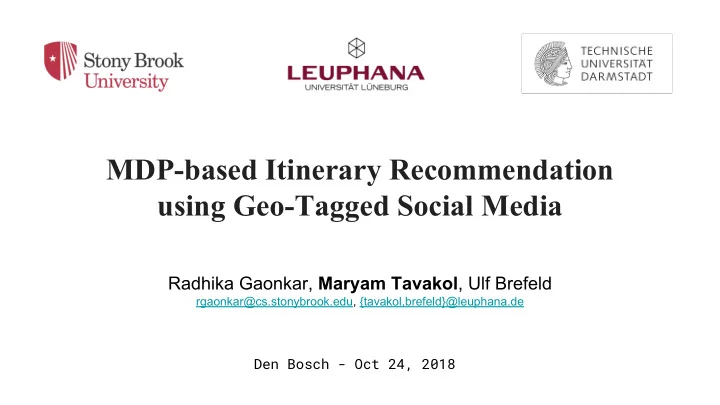

MDP-based Itinerary Recommendation using Geo-Tagged Social Media Radhika Gaonkar, Maryam Tavakol , Ulf Brefeld rgaonkar@cs.stonybrook.edu, {tavakol,brefeld}@leuphana.de Den Bosch - Oct 24, 2018
Travel Itinerary 2
Motivation Challenges in trip planning: ➔ Many decisions to be made at once while planning a trip: Duration of trip, costs, places to visit, food and many more! ➔ The Web provides an overload of information ➔ There is no one resource that exhaustively covers all the aspects of travel Automatically gathering personalized trip related information from different sources 3
Problem Setting Recommend a sequence of POIs (Point of Interests) given individual user preferences • A sequential problem • An instance of constructive learning • Based on previous visited POIs 4
Data Acquisition 5
Data Acquisition •We turn a photo-sharing site (Flickr) into a useful resource for reconstructing a user’s trip •The photos include: • Geographical coordinate (small-fraction) • Timestamp of capturing the photo • Semantic data; tags and titles 6
Example Time Geo coordinate Semantic data 7
Obtaining POIs •Photos with location coordinate (small subset) •Photos without coordinate information • Inferring the POI from Latent Semantic Analysis (LSA) to compute the semantic similarity between the tags of the geotagged and non-geotagged photos 8
POIs from Geo-coordinates 48.174135 Olympia Park 11.547317 ➔ Query API with 48.177082 coordinates BMW Museum 11.558003 ➔ Limit search radius Fuzzy match place ➔ name with tags Assign place with ➔ highest match 9
Non-geotagged Photo 10
Geotagged Photo 11
POI from Text Similarity Gets the same location 12
Resident vs. Tourist 13
Itinerary Inference Bounding box of city 14
Learning the model 15
Procedure Path Obtaining POIs Learning MDP Personalization Recommendation 16
Reinforcement Learning •A touristic trip is considered a sequential problem •The photos provide implicit feedback on the user’s preferences A match for RL-based approaches Encode the history of previous visits in a Markov model 17
MDP Definition • State : a sequence of at most k places the user visited up to time t • Actions : all POI categories present in the city • Reward function : higher reward when the recommended action is taken by the user • Transition function : probability of transition between two states after taking an action • Goal : maximize the sum of discounted reward 18
Learning the Model •Estimating the state-transition function & reward function using maximum-likelihood method •Optimizing the MDP via Value Iteration algorithm, V(s) •The state-action values, Q(s, a) , are obtained from the learned value function • The Q-value gives a score for every place category 19
Path Recommendation Places having the optimal category MDP Model POI 1 Optimal category POI 2 Next location Current location Closest POI ... POI n 20
Personalization 21
Personalization Score •Duration-based • The amount of time a user spends on a specific category • Spends at least 2 hours in every museum •Frequency-based • The frequency of visiting a certain category • Often eats at Italian restaurant 22
Online Personalization •A POI is recommended based on both distance & personalized preference •The place in the optimal category: Weighted( distance + personalized score ) 23
Evaluation 24
Evaluation •Photographs of Munich, London, Paris •Leave-one-out cross-validation method •Performance measures: • Partial path accuracy • Exact path accuracy •Baselines: • Breadth first search (BFS), Dijkstra, Heuristic Search, A* 25
Partial Path Accuracy - Order of Markov Chain Path Length 1 2 3 4 5 6 1st order 0.041 0.041 0.042 0.042 0.041 0.034 2nd order 0.098 0.090 0.096 0.106 0.100 0.103 3rd order 0.097 0.090 0.093 0.105 0.090 0.087 4th order 0.089 0.084 0.083 0.094 0.077 0.060 5th order 0.074 0.071 0.058 0.072 0.070 0.058 •Encoding more history into the state improves the performance 26
Comparing Personalization Techniques •Duration-based outperforms frequency-based 27
POI Recommendation vs. Baseline -- Munich Exact path accuracy Partial path accuracy 28
POI Recommendation vs. Baseline -- Paris Exact path accuracy Partial path accuracy 29
POI Recommendation vs. Baseline -- London Exact path accuracy Partial path accuracy 30
Conclusion •An RL approach to recommend user itinerary: • Utilize freely available data from social media • Minimal manual intervention in data creation process • Computationally inexpensive • Outperforms standard path planning methods 31
Question? Thanks for your attention Currently looking for Postdoc position Maryam Tavakol tavakol@leuphana.de http://ml3.leuphana.de/maryam.html 32
Recommend
More recommend